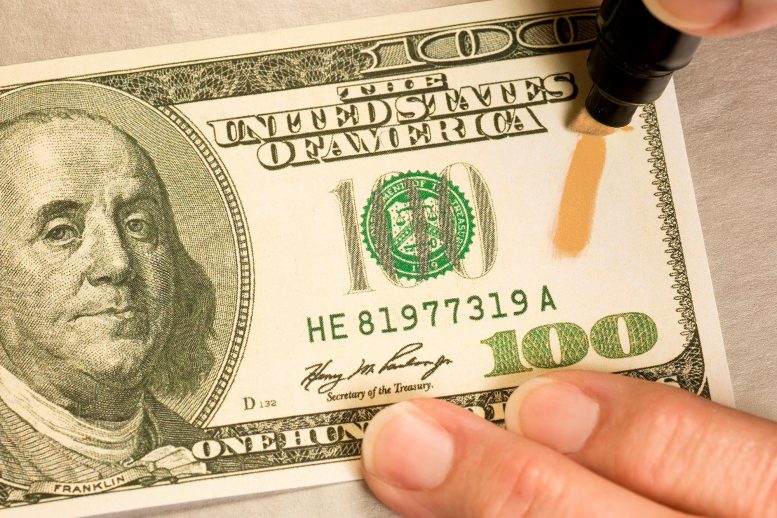Using Clever Chemistry to Outsmart Counterfeit Detector Pens [Video]

This video explores the chemistry behind counterfeit detection pens and several experimental ventures to alter their reaction with starch. The discussion also extends to the wider subject of counterfeit money detection, emphasizing the complexity involved.
Counterfeit detector pens utilize a starch-iodine reaction to spot fake bills. The question is, can their functioning be tricked by employing chemistry? In this episode, we delve into the chemistry of iodine, investigating its color, clock reactions, and the possibility of turning a side profit.
Video Transcript:
Imagine wanting the experiment with these counterfeit detection pens and figuring out how to prevent this reaction from happening on regular paper.
Believe me, my search history is chaotic.
(background groovy music)
Anyone looking at my online shopping activity might conclude I’m producing counterfeit money, which, technically, I did.
I should clarify that making counterfeit money is illegal and ethically wrong. Plus, it’s also challenging and this is definitely not a tutorial video for that purpose.
ACS Legal, is this explanation acceptable? Can we proceed with the video?
These pens contain an iodine solution, often a compound like potassium iodine is used to make non-polar iodine soluble in water. When you swipe these pens on a piece of non-currency paper containing starch, they leave a dark mark behind. That’s pretty much it.
These pens solely involve a simple reaction between iodine and starch.
Keep in mind that most traditional papers, such as printer paper, have a starch component.
If you remember our soft bread episode, amylose, long glucose molecule strands, form some of these starches and can bend into spirals.
In the pen, iodine and iodide ions combine to produce a triiodide complex.
I understand, it sounds complicated. Let’s head over to the whiteboard.
Okay, here it is. Iodine is the element, iodide is the ion, and three of them together form the triiodide complex.
Clear? Wonderful.
I think I have it all.
Understanding this reaction is crucial because when you swipe the pen on the paper, these triiodide complexes enter the amylose spiral and cause a dark purple or brown color to appear.
This is why you get the same reaction when you test on a starchy food, such as a potato chip.
Hence, iodine plus starch equals a brown mark on regular paper. However, currency paper is different. It’s mainly a blend of fabric fibers and does not contain any starch.
So, when you swipe the pen across a legit bill, no color change happens because there is no starch present.
The color change in iodine is dependent on the substance it is dissolved in.
In its solid state, iodine resembles a grayish metal with a purple vapor.
If you add some iodine solution to oil, you will witness a beautiful violet color.
There’s a chance you might consider this color purple.
The color we perceive is the light being reflected off the molecules.
Some light is absorbed, causing a rearrangement in the molecular orbitals, while some is bounced off. We see the light that is reflected.
The color may change if the wavelengths of the absorbed light change.
The color of iodine varies according to its solvent.
For instance, when iodine is added to water, the solution transitions from a purple shade to a more yellow-brown color.
This is, in part, due to the electron interaction between iodine and water molecules.
Weak donor acceptor complexes can form between iodine and water, which modify how electrons respond to incoming light. This changes the absorbed light wavelengths, which in turn changes the seen color.
When the iodine solution in the pens interacts with paper starch molecules, we get a kind of purple-brown color.
You may recall my mentioning of triiodide complexes infiltrating the amylose spirals as a possible cause.
There are more dynamics to this, and research into the specifics is still ongoing, as it’s quite captivating.
These pens harbor a very diluted iodide-iodine solution, which has almost no color to it.
There are I2 molecules, triiodide complexes, and potassium iodide floating around in it. To most extents, it appears slightly pale yellow at best.
However, when the triiodide molecules slide into the starch amylose spirals, I2 molecules accompany them.
Electrons that absorb the incoming light can now conveniently shift back and forth between the I2 and I3 molecules, since they are in close proximity. This changes not just the resulting iodine color, but also its intensity.
This is how we get the intense blues and dark browns seen when starch and iodine are combined.
The proposition of varying lengths of polyiodine chains present inside the amylose spirals is ranging from what we discussed - three to four - to as many as 160.
There's a significant amount of variability to consider.
In 2022, a research team suggested that short chains might enter the helix and undergo rearrangement. This could result in the creation of longer chains and possible alterations to the helix's structure itself.
The interaction can vary depending on the length and structure of the amylose helices, the amount of water present, and the purification process of the starch.
Many factors can potentially influence the color produced as you run the pen across the paper.
But what can we do if we want to prevent this interaction from occurring? Since removing iodine from the pens isn't an option, we ought to explore pathways of eliminating starch from the paper.
Starch is a polymer comprised of sugar molecules. One approach to breaking it down could involve introducing heat.
Starch begins to decompose at temperatures around 280 degrees Celsius or 536 degrees Fahrenheit. However, with my oven going up to only 500, and the paper catching fire at approximately 233 Celsius or 451 Fahrenheit, it's best to set the oven to 425 and try to partially break down the starch without setting the paper on fire.
(pan bangs)
This experiment should not be attempted at home.
I made sure to have a fire professional on standby in case of emergencies.
(container rustling)
(incorrect buzzer dings)
This is why biochemistry is my preferred field. I have a soft spot for the ferocity of enzyme-catalyzed reactions, particularly the ones involved in breaking down starch, like amylase.
Amylase catalyzes the reaction that under normal circumstances requires a temperature of 233 degrees Celsius to take place, bringing the needed temperature down to a more manageable 65 to 75 Celsius.
Interestingly, saliva contains a significant amount of amylase meant to break down starch present in the food we consume.
So, my plan is to apply some amylase, sourced from the internet, to a piece of paper but assuredly not by licking it. The amylase, mixed in water at a ratio of 1/2 teaspoon per gallon, will be simmered with the paper at approximately 70 Celsius or 158 Fahrenheit.
Amylase is known to break down starch chains into smaller sugars such as maltose and glucose. Observing the bubbles forming on the surface, I speculated if the heating of the water and the resultant breakdown of the starch into sugars was causing it.
However, this hypothesis revealed little success.
(incorrect buzzer dings)
One could potentially use yeast, which creates and utilizes amylase, to conduct this experiment, albeit in a more odorous fashion.
(incorrect buzzer dings)
Another idea could be to block iodine's interaction with the starch rather than attempting to break the starch down.
A physical barrier could be created using a hydrophobic substance like hairspray.
(hairspray whooshes)
Unfortunately, this method was unsuccessful as it accelerated the reaction instead of inhibiting it. Thus, hairspray is ruled out.
(incorrect buzzer dings)
Vitamin C could possibly remedy this situation. Vitamin C, or ascorbic acid, reduces iodine into iodide ions, which appear colorless in a solution.
We can coat our paper with vitamin C dissolved in water, dry it, then use the pen to test the reaction.
A much welcomed result, the vitamin C served its purpose well.
(correct buzzer dings)
Expanding on the principle, I attempted the iodine clock reaction technique, albeit this wasn't my own experiment. It was the brainchild of Nile Red, whose dose of fascinating science I thoroughly enjoyed.
In the experiment, I filled one beaker with water, iodine, and vitamin C, and another one with water, hydrogen peroxide, and starch. When mixed, the two colorless solutions remain unchanged before turning into a dark liquid unexpectedly.
Unfortunately, it seems that my iodine concentration was slightly lacking.
(bright tone beeps)
(bright subtle music)
Nevertheless, my spirits were buoyed when an off-camera beaker showed signs of success.
(instructor chuckles)
The sudden color change is attributed to the numerous reactions taking place. For instance, the hydrogen peroxide is causing the iodide ions to revert to I2 or iodine. But as long as there's vitamin C present, the iodine keeps being reduced back to iodide.
But eventually, the vitamin C runs out, the I2 forms up, comes together with some other I-minus ions to form those triiodide complexes we talked about before.
Those hang out with starch, and bam, color.
So freaking cool.
What was this video about again?
Right, counterfeit money.
Because none of this happens in real currency paper, because there’s no starch in it.
US currency paper is made by Crane & Co.
They were handpicked, no lie, by Paul Revere, to make the first US currency,
and they’ve just stuck ever since.
The paper also has red and blue colored filaments running through it, making it hard to duplicate, and Crane & Co won’t sell it to you.
But this stuff is some paper that I bought off of Amazon, so you can buy a paper that might already fool a tired, underpaid cashier just trying to finish their shift and check your bill.
Right, it’s definitely a different color from the printer paper.
So there’s printer paper and then Amazon paper.
There’s the real bill, and I don’t think it’s fooling anybody.
I bet they spray it with a little starch for this purpose.
And most real counterfeiters aren’t buying stuff like this.
They’re bleaching small denomination bills to get the right paper, and then printing larger denominations on it.
So these pens are one of the weakest methods of counterfeit detection for a number of reasons.
So was all of this for naught?
I mean, no, the chemistry was worth it.
You learned something, didn’t you?
I did.
I actually haven’t tried this pen on this paper yet.
Also, fun fact, this paper has red and blue filaments running through it.
Like, you can just buy with red and blue fibers in it.
What are they doing?




